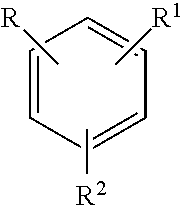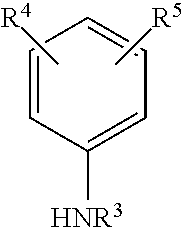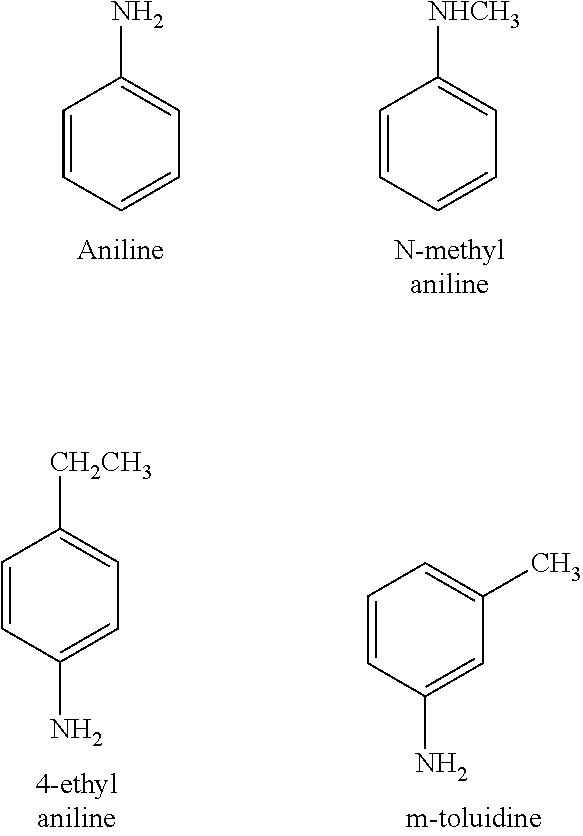Unleaded fuel compositions
a technology of unleaded fuel and composition, which is applied in the direction of fuels, mechanical equipment, machines/engines, etc., can solve the problems of progressively more difficult production of fuels of progressively higher octane values
- Summary
- Abstract
- Description
- Claims
- Application Information
AI Technical Summary
Benefits of technology
Problems solved by technology
Method used
Image
Examples
experimental examples
[0075]Synergies sometimes exist between compounds in fuel compositions which give results for certain properties that would be unexpected from traditional or theoretical methods of estimating that property. A large number of fuel compositions were tested to identify fuel compositions which have synergistic effects so as to yield unleaded fuel compositions having octane ratings of about 105 or more. Five unleaded fuel compositions (Blends 1-5) exhibited synergistic effects resulting in octane ratings of about 110 or more.
[0076]The blends tested had the following fuel components: Iso-octane=2,2,4-trimethylpentane; Iso-pentane=2-methylbutane; EtBE=Ethyl t-butyl ether (t=tertiary); toluene; m-xylene=3-methyltoluene or 1,3-dimethylbenzene; Aromatic amine=Aniline, N-methylaniline, 4-ethylaniline, and m-toluidine (3-methylaniline). In several of the tested blends, including Blend 5, the relatively expensive iso-octane and isopentane were replaced with relatively inexpensive alkylate. This ...
example 1
[0077]A first blend had the following general formula:
Blend 1
[0078]
ComponentVol. %Iso-octane45-50%Toluene14-18%m-Xylene12-16%Iso-pentane 3-7%1,3,5-trimethylbenzene12-16%Aromatic Amine 5-10%
[0079]The following formula within “Blend 1” was prepared and the octane number was determined:
ComponentVol. %Iso-octane45.5% Toluene15%m-Xylene14%Iso-pentane4.5% 1,3,5-trimethylbenzene14%Aniline 7%
In all of the examples, the RON, MON, and octane rating [R+M) / 2] were measured according to ASTM D-2699-04a (RON) and ASTM D-2700-04a (MON)(2004). For the foregoing blend, the RON was 115.67, the MON was 106.0, and the octane number was 110.8.
example 2
[0080]The following formula within “Blend 1” was prepared and the octane number was determined:
ComponentVol. %Iso-octane45.5% Toluene15%m-Xylene14%Iso-pentane4.5% 1,3,5-trimethylbenzene14%m-toluidine 7%
The RON was 116.67, the MON was 106.33, and the octane number was 111.5. The foregoing results demonstrate that the formulas of Example 1 and Example 2 are effective to produce an octane number of 110 or more.
PUM
| Property | Measurement | Unit |
|---|---|---|
| vol. % | aaaaa | aaaaa |
| octane rating | aaaaa | aaaaa |
| octane rating | aaaaa | aaaaa |
Abstract
Description
Claims
Application Information
 Login to View More
Login to View More - R&D
- Intellectual Property
- Life Sciences
- Materials
- Tech Scout
- Unparalleled Data Quality
- Higher Quality Content
- 60% Fewer Hallucinations
Browse by: Latest US Patents, China's latest patents, Technical Efficacy Thesaurus, Application Domain, Technology Topic, Popular Technical Reports.
© 2025 PatSnap. All rights reserved.Legal|Privacy policy|Modern Slavery Act Transparency Statement|Sitemap|About US| Contact US: help@patsnap.com



